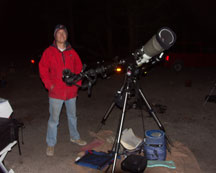
At the scopes on Friday night
Saturday (crepes!) breakfast lecture on the comet impact layer and what we will be looking for, as well as passing out supplementary material on planetary science, and maps for the day.
This field astro class was more packed than usual with opportunities for astro-science adventure. We succeeded in many of them, missed on some, and all-in-all had an exciting weekend. We had good support from the astronomy club - Kirk Bender, CSU East Bay Professor Chris Kitting, and Eric Messick brought their scopes and donated their efforts, and Shahram Tarani came Saturday and gave a demonstration of astrophotography. Friday evening began with a pasta dinner and telescope study of Jupiter and its moons. At 11:20am the Delta Aquarid radiant was rising, and we set out our sleeping bags and did a 40 minute meteor count. I passed out paper and instructions to all, and how to log the important data without breaking their attention visually on the sky. I'll reduce the data and post it when I get a chance. Next morning I cooked our traditional French Crepes breakfast, and then prepared for a busy day.
At the scopes on Friday night |
Saturday (crepes!) breakfast lecture on the comet impact layer and what we will be looking for, as well as passing out supplementary material on planetary science, and maps for the day. |
First project for Saturday was to examine the Black Point ash deposit near Wilson Creek. This deposit is due to a period of eruptions 13,600 to 13,300 years ago. This happened beneath Pleistocene Lake Russell, the much larger progenitor of today's Mono Lake. The Firestone etal (2007) paper which I passed out onsite proposed a Pleistocene comet impact 12,900 years ago which produced a layer of dark material rich in charcoal, magnetic particles, carbon spherules and nanodiamonds. We hoped therefore to find a dark layer just above the Black Point ash deposit, which itself is a layer a couple of feet thick. Allowing for inaccuracies in age dating, the impact layer might be below the Black Point layer, or even mixed within it. Our plan was to search for dark layers near the Black Point ash layer at a road cut near Mill Creek, and at Wilson Creek nearby.
|
...overlying flat ash deposits. How could this happen? |
A dark layer just above the BP complex, and an animal burrow. Could it be...? |
|
Farther up, we find a slope giving access to the ash layer. |
The Black Point ash layer above silt layers. |
|
Chris discovered these interesting "vinegar nematodes" in the stream, and impromtu'd a micro-lecture for us. |
|
Our group, just before the lecture on geothermal hot springs and comparison with possible Martian springs. |
|
Look out, he's got a bomb! A "breadcrust bomb" as described by the ranger. Formed by rapidly cooling wad of glass tossed up by the volcano. The rapid cooling causes a surface of criss-crossing cracks much like fresh baked bread crust. |
Chris Kitting's video record of our graze is far superior to that done with the department's PC 164c, which suffered due to the strong dawn light. He'll be sending it to me to post here by the end of August. The graze timings are here.
Esther has posted a nice gallery of pictures from our class as well. Enjoy them here.